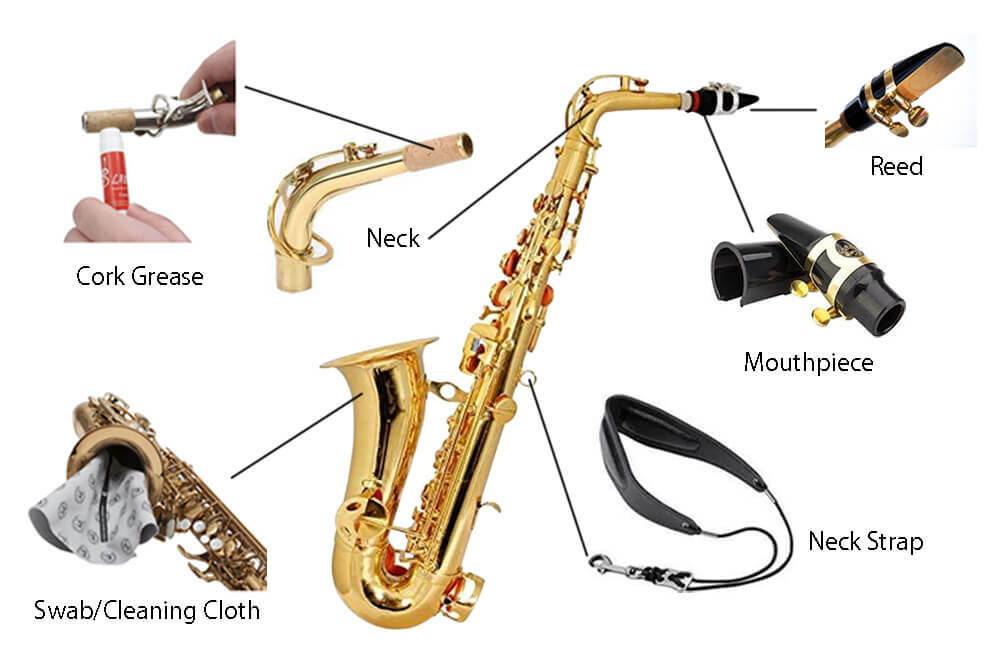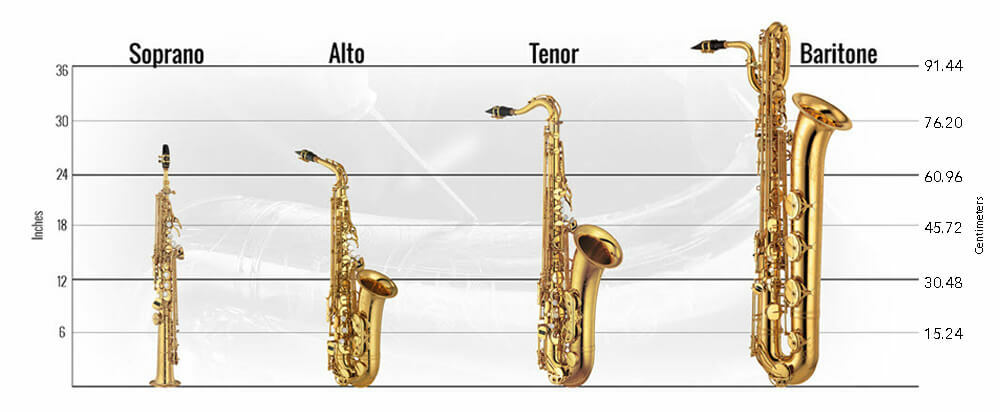
The saxophone is a versatile woodwind instrument that carries a wide range of tones from a clean high pitched sound to a powerful low bassy tone. Despite their sophisticated appearance, saxophones are not as difficult to learn as they look.
You can learn to play a song on a saxophone in 30 days. There are 3 important areas you need to focus on during the initial learning phase, your Embouchure, your Air Delivery, and Fingering Patterns for the notes of your song.
-
Embouchure – the way in which your lips create a seal around the mouthpiece to produce a full sound (tone). You can achieve this within an hour of experimenting on your first day. You’ll get more comfortable with your embouchure as you practice. You may do this exercise using just the neck with the mouthpiece attached.
-
Airflow – practice your air delivery using your diaphragm and focus on maintaining a steady breath of air blowing into the mouthpiece. Airflow is important for producing a steady tone. With an hour of practice a day, you should be able to produce an acceptable tone in 2 to 3 weeks’ time.
-
Fingering pattern – Unlike pressing down a chord on a stringed instrument, saxophones notes are fairly straightforward, following a specific set of fingering patterns for each note. The keys on the saxophone are also easy to hold down. All you need to do now is find the notes for the song you want and start practicing.
If you’ve always wanted to learn the saxophone and you’re up for the challenge, the following topics will provide you with a little more information on what you need to know:
-
What Do You Need to Know When Learning The Saxophone
-
How Many Types of Saxophones Are There?
-
How Heavy Does a Saxophone Weigh?
-
How Much Does A Saxophone Cost?
What Do You Need to Know When Learning The Saxophone
Below are a few major things you need to know that can help improve your learning experience as a beginner.
Am I too old to learn the saxophone? You’re never too old to learn anything, but in the case of the saxophone, you might be too young to start if you’re 10 years old or younger. Due to the size and weight of the instrument, it is recommended that you should be at least 8 to 9 years before considering learning the saxophone.
Also, make sure to check that you do not have too small a hand and might struggle to get your fingers around the body of a saxophone.
Picking out the right saxophone. For beginners, the Alto saxophone would be your best choice. It’s smaller, lighter, and easier to handle than a Tenor Sax or a Baritone. It is also much easier to achieve a good tone on an Alto than you would on a Soprano, Tenor, or Baritone, hence allowing you to start playing some simple melodies in a short amount of time.
Buying the bare necessities. Apart from the saxophone itself (made up of the neck and horn/body), below are a few things you will need from the beginning. Any pad clamps or fancy ligatures are unnecessary at this moment, you may decide upon them later down the road.
-
Neck Strap – You’ll need a neck strap in order to carry the weight of the saxophone on your body (neck). The neck strap is also used to ensure that the saxophone is set at the right height with the mouthpiece at your mouth level, and your hands are free to play without having to carry the weight of the saxophone.
-
Cork Grease – Cork grease is applied to the cork on the neck of your saxophone, making it easier to attach your mouthpiece. Alternatively, you may use vaseline or a lip balm if cork grease is not available.

The above-mentioned items, together with a protective casing, are typically included with the purchase of your saxophone, but since it may vary between sellers, it’s good to check if they’re available with your purchase.
One last thing that you will need during your practice is a Metronome. For beginners, you may not need it right away to play to a beat, but a Metronome is particularly useful when you’re measuring how long you can hold a note during your initial exercises. Nowadays you can easily download a Metronome app for free on your smartphone.
How Many Types of Saxophones Are There
There are 4 main types of saxophones that are the most commonly played, in order of the highest pitch to the lowest we have Soprano, Alto, Tenor, and Baritone.

The Soprano saxophone is the smallest, lightest, and has the highest pitch (tuned to B-flat) of the 4. Due to its structure and a smaller mouthpiece, it is also more difficult to play, especially in the sense of producing proper intonation.
An Alto saxophone is the next one up in terms of size, and the next one down in terms of pitch (tuned to E-flat). Due to its structure and size, the alto saxophone is most commonly recommended as the starting saxophone for beginners.
The Tenor saxophone has a similar shape to that of an alto but is longer in height, hence lower in pitch (tuned to B-flat). For a beginner, a tenor saxophone can be your choice of instrument but you’ll have to take into account the heavier weight, can your hands wrap around the body, and that it requires a bigger lung capacity.
The Baritone saxophone (tuned in E-flat) is the largest of the 4. With a much longer chamber, the baritone produces a very low pitch and requires a lot of air to produce a note. Hence it’s mostly played by experienced players (like in an orchestra) and is not recommended for beginners.
How Heavy Does a Saxophone Weigh?
Soprano – average weight: 2lbs 2oz / 1Kg
Alto – average weight: 4lbs 5oz / 2Kg
Tenor – average weight: 6lbs 4oz / 3Kg
Baritone – avergae weight: 11lbs 1oz / 5Kg
How Much Does A Saxophone Cost?
Soprano – average price: USD$650 – $5,300 (HKD5,000 – $41,600)
Alto – average price: USD$280 – $5,500 (HKD$2,200 – $43,000)
Tenor – average price: USD$800 – $9,000 (HKD$6,300 – $70,000)
Baritone – average price: USD$2,700 – $7,500 (HKD21,000 – $59,000)
*pricing based on ‘The Pricer’
Here’s a little side note on buying your first saxophone. Nowadays, you’re more likely to get a saxophone that is both cheap in price and good in quality (at least in a playable state). Try to buy brand new as secondhand saxophones may come with unforeseen issues, wear and tear, etc.
Buy from a source/brand you’re familiar with and in the instance of online shopping, make sure the store you purchase from provides some form of quality assurance or money-back guarantee.
In conclusion, learning to play the saxophone is not a difficult task. You can easily start playing a few simple melodies within weeks of starting out. And as you get more comfortable with your embouchure, and air delivery, and start to learn some music theory and notes, you’ll be able to play more challenging pieces.
But like all things, getting really good at playing the saxophone does require consistent practice and patience. Advanced breathing techniques and fingering control are just 2 areas you’ll start to focus more on when you get better.
Here in the following links are people sharing your progress of learning the saxophone without prior experience. In the first 3 examples, you’ll see the process of each individual starting out on day 1, and their respective results by day 30.
Technique references:
Rock on nn/,



